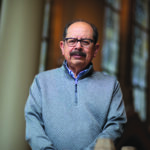Erasmo Gamboa

Professor Emeritus Erasmo Gamboa (American Ethnic Studies), is recognized for his tireless efforts bringing to light the role of Latinos/as in our region and nation. Gamboa’s service includes decades-long engagement with the Sea Mar Community Health Center and more recently with the Sea Mar Museum of Chicano/a Latino/a Culture, the first museum of its kind in the Pacific Northwest.
Professor Gamboa talked with colleague and UWRA board member Juan Guerra about the role of service in his life.
Why has service been so important to you?
I like to think that comes from my parents. We were raised as practicing Catholics, and doing for others as well as for yourself was instilled into us. Growing up in Sunnyside, that tradition was carried on by my aunts and my uncles. For example, when they learned of a death, they self-organized and provided for the grieving family. It’s a tradition that goes back to Tejas and perhaps to Mexico. And that was carried on in Yakima.
Growing up in Sunnyside, and during time in naval aviation in Vietnam, Gamboa saw how the lives of Mexican Americans were often left out of stories being told in the wider culture. This experience informed his scholarship as a historian, where “my intention was always not to focus on what is known, what others have done, but to shed light on the history of my community.” Eventually, “That is what gave rise to the Sea Mar Museum. To tell our story in our own way—the story of the activism of Latinos in Seattle in the 1960s, but also of the generation of people who came to eastern Washington, the farmworkers.
“My intention was always not to focus on what is known, what others have done, but to shed light on the history of my community.
”
What continues to motivate your dedication?
Over the years, Sea Mar has raised millions of dollars. And where does that money go? It goes to scholarships for Latinos and Latinas across Washington. If students who got the scholarship and are now in college or university are in financial difficulty, Sea Mar helps them as well. We provide public housing, we offer Christmas parties for those in need across the state.
At this point, it’s not just a dream of realization. You can actually see the effect of the effort. Some of my former students are now practicing, are family doctors at Sea Mar. And you see that and it’s very, very rewarding. You want to continue to do even more.
Has your perspective on community service changed as you’ve gotten older, especially since you retired?
I think that doing what I do only strengthens my commitment and it tells me there is so much else to do. I would like to do much more. My heart really is with Sea Mar and the museum.
I was able to be successful as a historian but also continue to work on behalf of the community, and that is extremely satisfying. I wanted to have a social connection, a social impact, and I’m happy that I did.

